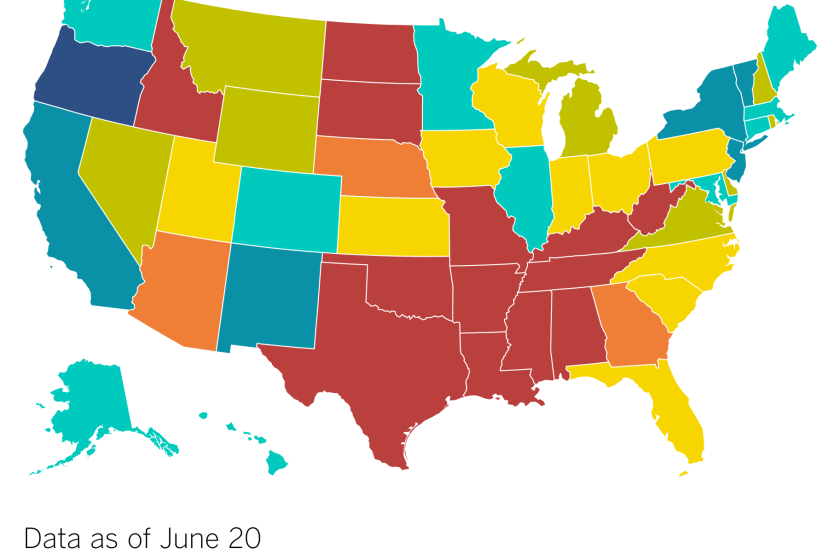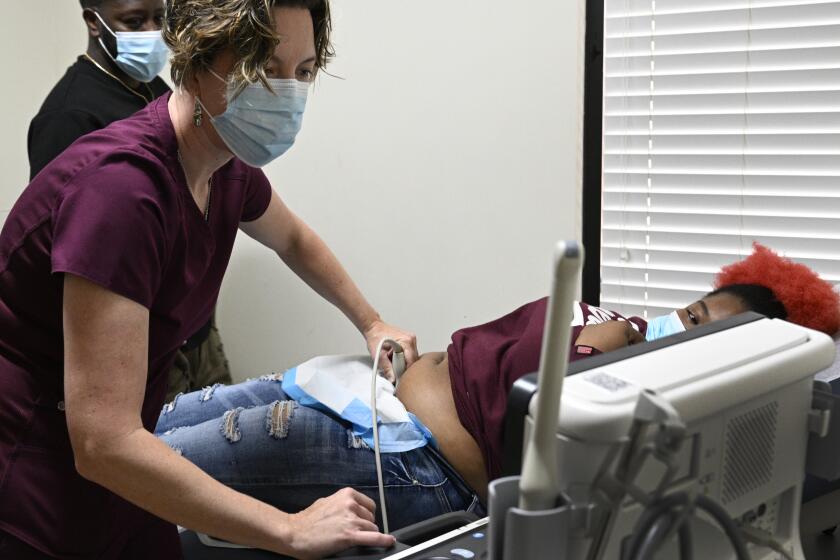Few U.S. adults support full abortion bans, even in states that have them, poll finds

- Share via
The majority of U.S. adults, including those living in states with the strictest limits on abortion, want it to be legal at least through the initial stages of pregnancy, a new poll from the Associated Press-NORC Center for Public Affairs Research finds.
The poll was conducted in late June, one year after the U.S. Supreme Court overturned Roe vs. Wade, undoing the nationwide right to abortion that had been in place for nearly 50 years. It comes as state lawmakers in Republican-led states have moved to drastically limit abortion access and as GOP presidential candidates wrestle with how to approach the issue.
While abortion laws have changed over the last year, the poll found that opinions on abortion remain much as they were a year ago: complex, with most people believing it should be allowed in some circumstances and not in others.
Overall, about two-thirds of respondents said abortion should generally be legal, but only about a quarter said it should always be legal — and only about 1 in 10 said it should always be illegal.
Most Americans polled thought their state should generally not allow abortions by the 24th week of pregnancy, near the end of the second trimester.
That’s the case for 34-year-old Jaleesha Thomas of Chicago.
“I’d rather the person abort the baby than harm the baby or throw the baby out or anything,” she said in an interview.
But she thinks that abortion should not usually be an option around 20 weeks into pregnancy.
“When they’re fully developed and the mother doesn’t have any illnesses or anything that would cause the baby or her to pass away, it’s like you’re killing another human,” Thomas said.
A year after the Supreme Court overturned Roe vs. Wade, leaving abortion decisions to states, where is abortion banned or protected? What comes next?
Thomas’ state — Illinois — allows abortion until the fetus would be viable, generally considered to be about 24 weeks. The state has become a destination for people from neighboring Kentucky, Missouri and Wisconsin who seek abortions, and from other places with bans on traveling for abortion.
The poll indicated that 1 in 10 Americans know someone who has either been unable to get an abortion or who has had to travel to get one in the last year, and that this is especially common among young people, people of color and those living in states where abortion is banned at all stages of pregnancy.
Nearly half of U.S. states now allow abortion until 20 to 27 weeks, but bar it beyond that in most cases. Before the end of Roe, almost every state fell in that range. Now, abortion is banned — with varying exceptions — at all stages of pregnancy in 14 states, including much of the South.
The poll also indicated that 73% of U.S. adults, including 58% of those in states with the strictest bans, believe abortion should be allowed at six weeks of pregnancy.
Just one state has a ban in effect that kicks in around then. That’s Georgia, where abortion is banned once electric activity can be detected in an embryo’s cardiac cells, which is around six weeks. That’s before most women know they’re pregnant, and before the cells begin to form a heart at nine to 12 weeks.
Ohio and South Carolina have similar bans that are not being enforced due to court action, and Florida has one that hasn’t taken effect. Iowa lawmakers late Tuesday passed a bill that would add the state to those ranks; Republican Gov. Kim Reynolds is expected to sign it into law later this week.
A former abortion clinic in Alabama evolves amid bans on caring for uninsured patients and offering post-miscarriage treatment and transgender care.
About half of Americans surveyed said abortions should be permitted at the 15-week mark, though 55% of those living in the most restrictive states said abortion should be banned by that stage.
And about two-thirds of Americans polled, including those who live in states with the fewest restrictions, said abortion should be barred at 24 weeks or earlier.
While most GOP-controlled state governments have been pushing for more abortion restrictions, the poll shows that there’s not always support for doing so. Nationally, about 4 in 10 people said it was too difficult to access abortion in their community, compared with about a quarter who think it’s too easy.
In the 1950s and 1960s, the LAPD’s abortion squad hunted down women getting the procedure and the people performing them.
Robert Green, an 89-year-old politically independent rancher in Wyoming, where a judge has put on hold a ban on abortion throughout pregnancy, said he has supported abortion rights since before the 1973 Roe vs. Wade decision.
“There’s a lot of reasons,” he said. “Not the least of which: The people who don’t want kids and go on and have them — the kids usually suffer for it.”
People in states with the strictest bans were slightly more likely to say abortion is too difficult to access compared with those living in the least restrictive states. Overall, about half of Democrats surveyed said it’s too difficult, compared with 22% of Republicans. And women were more likely to say access was too challenging in their area.
But among both Republicans and Democrats surveyed, there was not much of a gender divide on the topic: About half of both Democratic men and women said it’s too difficult to access abortion, compared with around 2 in 10 GOP men and women. But nearly half of politically independent women said it was too hard to access abortion, compared with about one-third of independent men.
The poll of 1,220 adults was conducted June 22-26 using a sample drawn from NORC’s probability-based AmeriSpeak Panel, which is designed to be representative of the U.S. population. The margin of sampling error for all respondents is plus or minus 3.9 percentage points.
More to Read
Sign up for Essential California
The most important California stories and recommendations in your inbox every morning.
You may occasionally receive promotional content from the Los Angeles Times.
















